I originally wrote this review for Monitoring Times Magazine, May 2013 issue (pages 56-57). The review that follows has been expanded and includes updates.
You may have noticed that in the past few years, while more and more software defined radios (SDRs) are appearing on the market, fewer and fewer traditional tabletop shortwave receivers are being introduced. Most of the receivers in production, meanwhile, are quite mature, having been in production for years. For those of us who still have an appreciation for the traditional front panel, tuning knob, and portability of an all-in-one tabletop receiver, perhaps we should look to the active ham radio transceiver market.
Introducing the Elecraft KX3
Besides being an avid SWLer (ShortWave Listener, for the newbies out there), I’m also a ham radio operator (callsign: K4SWL). But if you’re not a ham, you may not be familiar with the innovative, US-based radio designer and manufacturer, Elecraft. First of all, note that “US-based” adjective: this is an increasingly rare phenomenon in the world of radio production, and it deserves a word of praise up front. Elecraft started life as a kit manufacturer, focusing on QRP ham-band-only radio transceivers that were effective, affordable, and maintained a very high level of performance. Their K1, KX1 and K2 transceivers are legendary, and I’ve had the good fortune to own them all at some point along the way. Their K3, introduced in 2008, became a benchmark transceiver and still tops the charts in performance; it’s truly a choice DXpeditioner’s radio.
In 2011, Elecraft introduced the KX3–a portable SDR transceiver with a full-featured knob-and-button user interface that doesn’t require connection to a computer to operate. At the Dayton Hamvention, the KX3 instantly drew crowds, as it was unlike any other transceiver on the market. I was there, and like others in the crowds around the Elecraft booth, I was eager to try out this full-featured transceiver, especially upon learning that even the basic, no-options model has a general coverage receiver. A ham transceiver with “general coverage,” incidentally, means that its receiver is not limited to the ham bands only; these receivers typically receive between 100 kHz and 30 MHz (i.e., the full shortwave radio spectrum). That morning at the Hamvention, I quickly made my way to one of Elecraft’s owners, Wayne Burdick, to ask him,“Would the KX3 make for a good shortwave radio receiver?” Wayne’s prompt response: “Yes.”
That was enough for me: more than ever, I simply couldn’t wait to get within reach of a KX3. Why? I love to travel and take radio along, but I’ve always had to haul separate transceivers and receivers for my separate-but-related hobbies: 1) ham radio and 2) SWLing. Perhaps the KX3 would suit both purposes? I was hopeful. If this was true, with a KX3, I could have a full-featured QRP transceiver and a shortwave receiver in one…and a portable one at that. Ideal!
I just had to get my hands on one to find out.
A closer look
Though the KX3 was introduced in the summer of 2011, it didn’t start shipping until a few months later, and there was a backlog of orders for it. Fortunately, my good buddy, Dave Anderson (K4SV), was among the first purchasers of the KX3, and he was generous enough (and trusted me enough!) to let me borrow it.
At first glance, the KX3 resembles just the faceplate of a tabletop radio: it has a large tuning knob, wide, clear amber backlit display, and a traditional set of function buttons and multi-function knobs…but not much else. Or so it appears, as there’s no bulky chassis. Connections for microphones, DC power, headphones, IQ out, key and PC interface are located on the left side panel of the radio, while the RF connection (a female BNC) is on the right side panel. The KX3 has built-in folding feet, quite sturdy, that allow the radio to be tilted at a comfortable angle for tabletop operation.
To best evaluate the KX3, I’ll first discuss some of the features that would interest a ham radio operator, then focus on those best suited to the SWLer.
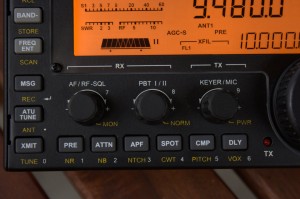
There is a hidden keypad for direct frequency entry (notice the numbers printed next to the multi-function knobs and buttons?)
Everything for the Ham
If you’re a ham, you’ll love the feature set on the KX3. It must be one of the most comprehensive set on any radio I’ve ever used. At a bare-bones level, meaning without adding any options, the basic KX3 is truly an all-in-one QRP transceiver.
Of course, it will function on any mode: USB, LSB, CW, data, AM and FM. The output power is adjustable from 0 to 10 Watts. You can easily adjust the DSP filters, AF, RF, passband, and notch all from dedicated buttons and knobs. It even has a memory keyers for both CW and voice.
You say you prefer digital modes? Not only will the KX3 natively decode RTTY and PSK31 and display the scrolling text on the display, but you can also send RTTY and PSK31 without a PC. How? Simply set the appropriate data mode and use your key to tap out your message in CW. Though you will hear the CW side tone, the KX3 will transform your code into RTTY or PSK-31, and send. Hypothetically, armed with only a KX3, you could run a RTTY contest from the field with no computer. Remarkable.
The variable DSP filtering is most impressive and the KX3’s ability to block adjacent signals is benchmarked. Indeed, if you look at Sherwood Engineering’s receiver test data rankings (http://www.sherweng.com/table.html), which are sorted by third-order dynamic range (narrow spacing), the KX3 is second only to the Hilberling PT-8000A, an $18,000 transceiver.
With the installation of the $170 optional internal automatic antenna tuner (the KXAT3), you will be able to tune most any wire antenna on the go, with no need to carry an external ATU.
In short, for the ham, the KX3 offers a cornucopia of features, too numerous to list here; but I can at least tell you that I discover something new on this radio almost every day and continue to be amazed by the features on this transceiver, especially considering that it costs only $1000 ($900 in no-solder modular kit form).
For the SWLer
We’ve talked about the KX3 as a ham radio transceiver, but how does it stack up if your primary interest is to just sit back and listen to broadcasts? Short answer: Very, very well.
The KX3 is loaded with features that would please even the most discriminating DXer.
First, on the faceplate, the KX3 has a multi-function knob that controls both the AF and RF gains. It’s very simple to use, even though I’m not a fan of switching between the AF/RF gain controls on the same knob. AF gain is what most of us refer to as a volume control and many dedicated shortwave receivers lack an RF gain control even though it’s a vital tool for broadcast listening in noisy conditions. By default, the KX3 RF gain is set to zero; turning the RF pot counter-clockwise will decrease RF gain.
The KX3 also has three different preamp settings, which are useful for amplifying weak stations, as well as an attenuator for local or strong broadcasters. The KX3 has passband and notch filtering, and an auto-notch function that effectively deals with heterodynes from nearby carriers. The KX3 also has DSP noise-reduction (NR) for noisy band conditions (or to help a signal “pop” out from the noise) and noise blanking (NB) for local RFI.
Many automatic gain control (AGC) parameters are adjustable, too, so they can be tweaked for AM fading and weak-signal DXing. The fact is, the KX3 has more built-in receiver controls than the dedicated tabletop shortwave receivers I’ve owned.
Audio
To be clear, however, there is one negative in the architecture of the KX3 when viewed through the eyes of an SWLer. The KX3 is designed around the amateur radio operator and AM bandwidth is narrower than you will find on most dedicated tabletop shortwave receivers–indeed, a commonality on any general coverage ham transceiver. The KX3’s AM bandwidth can only be widened to 4.2 kHz–a figure that almost made me dismiss this radio’s SWLing abilities out of hand. I’m glad I didn’t let that spec stop me, though: I had read many a favorable comment from KX3 owners who used the radio to listen to the broadcast bands. Their comments on the audio were very positive, and for good reason.
What the KX3 lacks in wide bandwidth is made up for by the 32-bit floating point DSP architecture. I’m not sure how, but the KX3’s audio fidelity “sounds” much wider than 4.2 kHz. Indeed, I still have a difficult time believing that the filter is not closer to 7-8 kHz in width. When using headphones or amplified speakers, the bass response rivals some of my tube receivers. There are even adjustable 8-band equalizer settings for audio to improve this even further.
In addition, Elecraft has unique audio effects available in the audio effects menu. One I’ve found very valuable in broadcast listening is called “delay,” a stereo simulation effect that broadens the mono sound in such a way that the audio sounds even richer.
Memories, scanning and tuning
The KX3 has 100 general-purpose VFO A/B memories with optional alpha numeric labels. It also supports channel-hopping or scanning within any number of labeled memory groups. Auto scan is simple and works in both muted and (my favorite) non-muted, or continuous, modes.
The KX3 can also use the “K3 Memory” application from Elecraft’s K3 transceiver, which allows for longer labels and the instant selection of desired memories from a PC. The “K3 memory” application is a free software download on Elecraft’s website.
The tuning knob on the KX3 is substantial and of good quality. It’s only slightly smaller than the tuning knob on my Alinco DX-R8T, so it’s a substantial knob, which is helpful to big (or buttery) fingers. The drag can be easily adjusted with a supplied hex wrench. The tuning rate can be adjusted to .5 kHz increments, allowing you to quickly tune through the band. The small multi-function knob next to the main tuning knob can also be set for a 1 kHz rate.
At first glance, you might not realize that the KX3 has a direct frequency-entry keypad. Check out the photo, however [MAKE REFERENCE TO POSITION ON PAGE]. The buttons and multi-function knobs in the lower left quadrant of the KX3 double as number pad, decimal point, and an “enter” button for a keypad. I thought this a bit odd at first, but now find I use this all the time.
Optional ATU: Worth the Cost
As I mentioned earlier, the optional automatic antenna tuner, the KXAT3, makes a lot of sense for the ham who operates portable. If you are a licensed amateur radio operator, the ATU can be a powerful tool for matching random length, or multi-band antennas to your desired broadcast band by tuning to a nearby ham band frequency. The L and C parameters of the tuner can be manually adjusted to optimize without transmitting. The user can select one of 8 L’s or one of 8 C’s parameters in the ATU MD menu entry. When an L is selected, C is set to 0, and vice-versa. However, it is not presently possible to select combinations of L and C to achieve a closer resonance. Still, selecting an L or C value in this way will provide a useful increase in gain.
In addition, if you like medium wave (MW) DXing, the ATU comes with MW (AM broadcast band) filtering that tracks the VFO, somewhat improving image rejection between 300-1,000 kHz. I have tested the KX3 on medium wave both with and without the ATU installed and find that it certainly improves rejection.
To be clear though, sensitivity decreases as you tune below 1,500 kHz. Elecraft informed me that it was necessary because the KX3 uses PIN diodes in its T/R switch, and the signal must be high-pass filtered to avoid IP2 problems with the diodes. When you tune through the 300-1200 kHz range (or so) you will certainly notice the loss of sensitivity. Elecraft also noted that selectivity in the AM broadcast band was not a major design criteria, so in this band the 160 meter low pass filter is used. This is not ideal from a harmonic rejection standpoint, and there will be some 3rd and 5th-harmonic images from strong stations. Adding the ATU helps with this. However, adding the ATU doesn’t generally improve sensitivity in this range.
The ATU is very easy to install–almost “plug and play” (see photo).
Oh, yes–and it’s an SDR, too!
As if the KX3 didn’t do just about everything, it also has a quadrature down-sampling mixer compatible with PC-based SDR (software-defined radio) applications. This means, via a shielded stereo audio patch cable and a supplied USB control cable, you can connect the KX3 to your PC and use a freeware SDR application like HDSDR to turn your KX3 into a proper software-defined receiver.
SDR functionality is limited to receiver functionality, and depending on the bandwidth and sampling rate, will be dependent on the quality of your sound card. The true benefit is the ability to see a wide–48 kHz or more–chunk of spectrum.
Summary
Every radio has its pros and cons. When I begin a review of a radio, I take notes from the very beginning so that I don’t forget some of my initial impressions. Here is the list I formed over the time I’ve spent evaluating the KX3. Note that I created this list with the shortwave listener in mind, not necessarily the ham radio operator.
Pros:
- World class, benchmarked receiver performance powered by high-performance 32-bit floating-point DSP
- Rich, full audio fidelity on AM despite limited bandwidth (see con)
- AF and effective RF gain controls
- Adjustable filters (no optional roofing filters needed for SWLing)
- Superb sensitivity and selectivity; outperforming even my WinRadio Excalibur with weak signal DXing
- Very low noise floor
- Auto-notch, which helps eliminate annoying heterodynes, even in AM
- Internal ATU option brings improved MW image rejection (see MW con) and hams have the ability to tune a random length antenna
- Natively decode (170 Hz) 60-WPM RTTY and display it right on the KX3’s VFO B display, which is alphanumeric
- Battery operation via 8 AA batteries
- Lightweight
- Dedicated headphone jack
- For non-ham radio operators, the transceiver can be disabled and re-activated once you have a license with a simple hardware adjustment. No need to fear accidental transmission
- For hams, or those who plan to become one, the KX3 is a QRP transceiver in the top of its class
Cons:
- AM bandwidth limited to 4.2 kHz (see pro)
- Hand mic connector is the less standard 3.5 mm audio plug
- Built-in speaker is small with limited volume and fidelity–only intended as a back-up when headphones or external powered speakers are unavailable
- AA batteries fit a bit tightly in internal holder and can present a challenge to remove
- Medium wave reception is mediocre at best, but with the optional ATU, is improved though slightly better image rejection (see ATU pro)
- Very slight audio whine (similar to a faint heterodyne sound) heard in some zero beat AM stations; may be fixed in future firmware update
- No AM sync detector (AMS)
Did I buy one? Confession time
I must admit, I was appreciating my buddy Dave’s KX3 very much. Maybe too much…
I have three hobbies: shortwave radio listening, ham radio, and traveling. After using the KX3 for a few hours, I knew it would be my perfect companion. Not only is it a top-notch amateur radio transceiver, its also an excellent shortwave radio receiver. It’s portable, but also makes an excellent tabletop radio. It’s an all-in-one radio, but can also double as an SDR when connected to a PC.
So, is the KX3’s broadcast audio fidelity as good as a purpose-built broadcast receiver like the legendary Drake R8B? Not quite. But I would argue that its ability to receive weak signals would give even a Drake a run for its money. I have to admit, the KX3 receiver outperforms my Alinco DX-R8T in every respect. Even though the AM bandwidth is limited to 4.2 kHz, I think the audio also sounds better than my Alinco and any of my portable radios with wider bandwidth.
Needless to say, I bought one. It was only fair to Dave, who needed to discover for himself what his loaned-out rig could do.
The KX3 is a game changer for me. Though I’ve always carried portable transceivers in my travels, I’ve also had to carry a separate tabletop receiver and an SDR or portable radio for my SWLing. No more. Moreover, I like the broadcast audio on the KX3 well enough to record and archive shortwave broadcasts, which I frequently do for my blog, The SWLing Post and The Shortwave Radio Audio Archive. In my shack, I’m even considering purchasing Elecraft’s 100 watt amplifier and doing away with my 100 watt tabletop transceiver.
As for support? No worries there. I’ve been an Elecraft customer for years and I can tell you that they believe in and stand behind their products. I purchased with confidence.
I encourage you to try on the KX3 as well. It may very well be all the radio you’ll ever need.

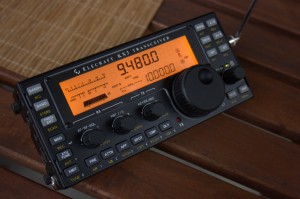
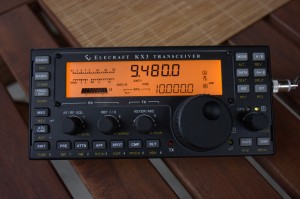
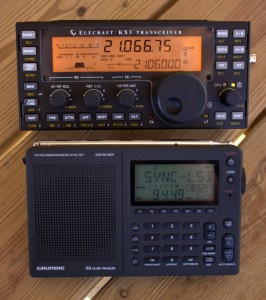
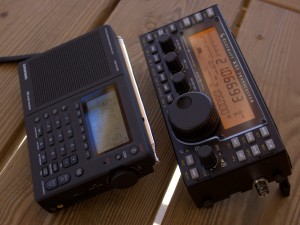
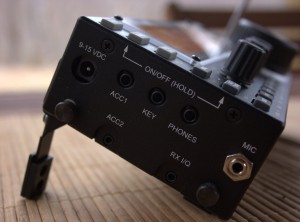
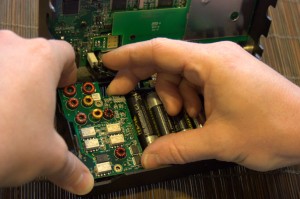
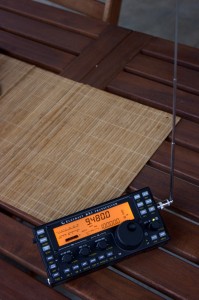
Pingback: Getting To Know You Series: The Elecraft KX3–My thoughts, notes, and one extreme QRPp contact! | Q R P e r
Pingback: QRP by Lantern Light: A CW/SSB sunset POTA activation at Lake Jame State Park | Q R P e r
Hello, Thomas! I’m curious about SWL antennae with the KX3 or KX2. I suspect you have written on the subject but did not find any.
Thanks
NU6T
Hi, Richard,
One I’ve paired while traveling is the PK-loop: https://swling.com/blog/2018/01/a-follow-up-review-of-the-pk-loop-c-loop-hdsw6-18-antenna/
You might also consider an MLA-30 active loop or the Youloop passive loop.
Keep in mind, though, you’ll want to do everything you can from accidentally transmitting into these antennas.:)
Cheers & 73,
Thomas
Superb, something that will become a classic piece in years to come-great to note that SWLing has taken the time to write this article. I do find the audio a little harsh but sensitivity is outstanding.
John G4YDM 73
When you’re in general coverage mode on AM, does the KX3 go up and down the shortwave bands or only the ham bands. I like how the Tecsun PL-880 does both, depending on what mode you’re in.
I am think about the KX3 transceiver. My specific use is on 10 meter FM. I am unable to find any specs on this unit in the 10 meter area on FM. I am currently using commercial 2-way radio equipment because of the low-distortion hi-grade audio. The distortion is generally less than 3% with 5 or 10 watts of audio. Moreover, with a properly tuned noise blanker as on the Motorola Syntor units (tuned within 3 Mhz if your received signal) is supper excellent for noise reduction and high-quality audio. I am unable to find any specs on the audio out-put and distortion level of the KX3. Please let me know if the noise blanker is effective on 10 FM. What is the receiver sensivity on 10 FM? I am used to .3 or better. Sometimes the noise blanker will reduce the sensivity somewhat depending how it has been tuned on the Syntor or Mitrek radios. I am hoping the KX3 has a low distortion audio spec and an active noise blanker on 10 meter FM which will be close to the commercial units. Please give me some assistance in this area, Thanks,
I am going on vacation this year in China. I should get the kit and assemble it there so that I will have a KX3 assembled in China.
Thanks for the review Thomas, and thanks to the commenters for their comments.
John, EI7IG
This interesting review reminds me of how, as a newly-minted college graduate, circa 1996, I coveted, but could not afford, any of the Lowe HF series or AOR AR7030 receivers I read about in “Passport to World Band Radio”. I settled on a Sony ICF-SW7600 instead, which I enjoyed nevertheless. Much more recently, I’ve read about receiver/transceiver prototypes (CDG2000 and HF7070) that seemed continuations of that lineage. I wonder how the KX3 stacks up against these as a shortwave receiver and if an apples to apples comparison can be made. What contemporary receivers now outperform the AR7030 for SWLing? Can anyone speculate?
The kx3 was never designed to be a SWL receiver. It was designed to be a kick ass QRP rig. The 7030 is an awesome receiver for the SWL listener and will outperform the Sony. I grew up with the Icom R70 and modified R71 and the NRD series and have seen the AOR series in action and the Drakes servred me well. Each has its purpose and sorry but I could not enjoy my Winradio and the Perseus because I grew up spinning a knob and not a mouse but at the end of the the antenna wins out.
Today I am thrilled with my Icom 7000 because it can hear beacons at 350 kHz whereas my Yaesu Ft-950 cannot and people tell me their SDR-1500 is useless below 1.8 MHz so it all depends on what you want to listen to. There are guys with modified Yaesu FRG-7 that will not change for anything.
Listen, learn, have fun, enjoy
I checked with Eric at the elecraft booth at Pacificon. For swling it’s best to disable the antenna tuner and you will notice a better swl experience.
The am filter bandwidth is totally fine for my ears
The speaker can be a weak point but the biggest is the fact it likes resonant antennas. Thus if you used the tuner for 40m and now are listening to utilities at 11 MHz you cannot use the tuner to peak the signal.
Thus the kx3 is not designed to be a portable swl radio for the avid dxer or as a killer MW receiver
What it does do for its intended purpose it does very well22
The tuner is very flexible. You can switch it out of the signal path if you like (Bypass setting), or manually peak the L and C values for whatever receive frequency you are on, outside of the ham bands.
Personally I don’t think the tuner is a drawback for utilities, BCB, or SWL at all; I think the way it operates is quite useful.
Guy
Thanksfor the teachings on the tuner…did not
Know that
Hi Thomas,
What is the antenna you used to review the KX3 as a receiver? I used a simple whip and compared its performance with the Grundig G3. However, the G3 turned out to be a better radio while the KX3 is a little deaf.
It works much better with an active loop antenna, but it is still not significantly superior than the G3. Either my KX3 isn’t working properly, or the little G3 is also a very descent shortwave receiver. Do you think this is normal?
73,
AC9FU
Chris –
I notice that you posed the same question on the Elecraft reflector and assume that you have seen N6KR’s answer by now. I hope you don’t mind me butting in here, but for the benefit of anyone else reading these comments, I’ll note that Wayne mentioned the KX3 was designed to be used with a full-size antenna, while the Grundig was designed for use with a short antenna, so has extra pre-amplification. However, you can program the KX3 to switch in extra pre-amplification on a band-by-band basis when using a short whip, and I think Wayne said it’s possible to switch in as much as an extra 30dB.
Try switching in the extra pre-amplification on the KX3 and then compare the two on a full-size antenna (is it possible to connect a full-size antenna to your Grundig?) A good test would be to try and receive a very weak signal that is close to a very strong signal. Lesser receivers will make this hard, whereas the KX3 should shine in this regard. Most receivers nowadays are quite sensitive and will sound good in non-challenging conditions, but give it a shot on, say, 49M at night where there are quite a few big signals, and try digging out a weak one amidst the powerhouses. That should give you a clearer idea of the capabilities of the KX3,
73,
Dave
AA7EE (who has been thinking about getting a KX3 for SWL’ing……)
Whats the longwave vlf performance like?
Hellow Thomas,
Thank you for your very interesting comment.
I have a good practice in CW traffic (radio officer for 30 years in merchant navy)
That is why, having seen and tried a K2-100 at a friend’s shack, I built it with all the options, including the amp 100 W, and 144 MHz transverter and I am very happy to have done that, enjoying mainly for its sensitivity and also to the selectivity offered by its filters (quartz and DSP).
And I use it mainly in CW qrp / p.
I see that you are an Elecraft “aficionados” and you probably know this tranceiver.
If this is the case, you seem to be well placed to make a succinct comparison between these two devices and give me your opinion on the interest that I’ll have to buy a KX3.
Except / decoding PSK RTTY, the fact that it is portable, low consumption and of course SDR function and all improvements using computers aids.
I refer mainly of transmission and reception quality …
Thank you in advance for your response.
73
Henri / F6IAX.
Is it possible to decode DRM broadcasts using the KX3 and external software?
73, Terry N6RY
Though I’ve never tried it, I should think it’s possible since the KX3 has I/Q out. You should only need an SDR application and DReaM (http://sourceforge.net/apps/mediawiki/drm/index.php?title=Main_Page). Of course, you’ll also need a 50 Euro DRM key if you haven’t purchased it already.
Cheers,
Thomas
Thanks for the information on the ATU Thomas. It would be nice if there was a way to disable the XMIT button function thru the menu for SWL’rs who hook this up to active antennas. If you accidently press it outside the ham bands it gives a message “end of band”, but it will put the KX3 in transmit mode if you are in the allowed ham bands. Just have to be careful.
2 Really cool accessories for the KX3 are a weighted dimple tuning knob from 73cnc : http://www.73cnc.com/SearchResults.asp?Search=kx3
And of course the sidekick end plates and cover from Gem Products: http://gemsproducts.com/
These do a great job of protecting the display and front plate of the radio.
Thanks again for the manual ATU info.
John
John, you can preset the transmit power down to its minimum of 0.0 watts. That way if you accidentally transmit, no RF is emitted.
Funny, I put mine on QTH Classifieds two weeks ago and it was gone in 10 minutes.
After careful consideration, I purchased the Elecraft KX3. It will mostly be used for SWL, but I will also use it for QRP sometime down the road.
I must say, I was very dubious about the 4.2 KHz filter, but this radio has blown me away with the AM and SSB audio. You are absolutely correct; it sounds much wider than the 4.2 KHz, but without the hets you would get with a filter that spec. It almost sounds like surround or stereo. Very pleasing, and non-fatiguing for long sessions. I have to finish the manual now. I need to figure out how to use the ATU without transmitting into my Wellbrook.
Thank you so much for your review and your recommendations.
John
Hi, John–
Sorry–I meant to respond to your previous comment. I haven’t done this in a year or so, but there is a way to manually adjust the values of the ATU. To be clear: it’s not a precise manual adjustment like some ATUs give you (say, like that of the K3).
I don’t have the KX3 in front of me at the moment, so I called Elecraft for a little guidance and to jog my memory.
Try this:
Put your KX3 in ATU MD mode (via the menu). Then, simply turn the main VFO (tuning knob) clockwise, testing L1, L2, etc… You can adjust the ATU manually by doing this–at least, you’re cycling through a few presets.
This process only changes the values of the ATU, it does not inject any RF into the antenna.
You might actually want to build a small portable manual tuner at some point and use it when space allows in your portable listening.
Glad you like the KX3. I do love that little rig–it’s a keep for both SWLing and QRP.
73,
Thomas
K4SWL
I see you also recommend the ATU for receive applications. I looked at the manual, and I see the auto tune application, but I cannot find an explanation of what is actually happening. Some ATU’s transmit a carrier signal during the tuning process, and if you are using this as a receiver and have it connected to a Wellbrook Active Loop antenna, you do not want this to happen. Can you tell me if you are using the auto tune function to match the antenna, and if so, doed the radio transmit at all during the process?
Thanks,
John
Now that you have had the KX3 for awhile, does your initial impression about the fidelity on AM shortwave receiving still hold? How about the audio fidelity in SSB mode? You said it sounded more like double the actual 4.2 KHz. How would you compare the audio, over headphones, against, say, a Sony ICF-2010 with the wide filter engaged? I have treble challenged ears, and I really need all the bandwidth I can get. The Sony ICF-2010 with the wide filter is one of the best sounding portables I have ever owned on strong signals in the clear.
Thanks,
John
Hi, John,
Yes, my impression of AM fidelity does still hold.
To be clear, though, the KX3 AM audio is good, but not as good as a Sony ICF-2010, however. The KX3’s sensitivity is probably better than the Sony, but the Sony was designed for good AM audio fidelity, the KX3 was designed for amateur applications.
With that said, I recently recorded a program on the KX3. You can listen to nearly an hour of it here:
http://wp.me/pn3uc-2gh
Cheers,
Thomas
I wonder if this is a legitimate review or a “paid” review. I want to get a transeiver but cannot decide between the IC-7000 or the KX3. Also, are they built in California or only designed in CA and built in China?
Augustin, I can assure you this wasn’t a paid review. I originally based the review on the KX3 I borrowed from my friend, Dave (K4SV). I liked it so much that I purchased my own KX3 and ATU (at full price) and finished the review. The review showed consistency between both transceivers even though Dave’s was an early model (serial number in the 0080s) and mine much later (ser number 3322).
The KX3–and all Elecraft radios–are designed and manufactured in California. Of course, the KX3 can be purchased as a modular kit (where you do the building at your QTH) or factory assembled in California. If you purchase the KX3 hand mic (instead of building or adapting one) it is manufactured in Japan.
The IC7000, by the way, is a great radio. While I believe the KX3 has a better receiver (check its specs against the IC7000 here: http://www.sherweng.com/table.html) the IC7000 might be a better value if you’re looking for a 100 watt mobile rig. I’ve also heard favorable reports about the IC7000’s general coverage receiver.
The KX3 is QRP only (as reviewed here). Elecraft has a matching 100W companion amp/atu in the works, but it’s not out yet and I imagine its price will be $600 plus. You can buy new IC7000s for $1250 and much less used.
Again, I personally prefer the KX3 over the IC7000, but if you want a 100 watt rig that you can mount in your car for $1200 or so, the IC7000 is certainly the way to go.
Cheers,
Thomas
Thank you for all that info Thomas. So would it be accurate to say that you sacrifice some radio coverage in exchange for less weight with the KX3? I say that because the IC7000 has a greater frequency coverage but it is much heavier. I understand that the KX3 has great reviews and it is a QRP radio, I am basically looking for a radio that can be taken to the mountains in a backpack and the KX3 seems ideal for it except that the frequency coverage is limited so in case I want to listen to anything in the higher frequencies I would not be able to like the 70 cm band.
The bulk of the weight the IC7000 has on the KX3 is in the 7000’s built-in 100W amplifier. In the future, the KX3 will have a 2M band module to allow at least some VHF coverage. I don’t think Elecraft has any plans to cover 440 MHz.
BUT: If you’re looking to backpack with a full-featured radio, the KX3 is–hands down–the choice. For $1000, you can get a factory built KX3 (save $100 by spending a day putting together the modular kit) and then simply purchase a dual band HT. I never hike without an HT anyway.
You would not want to do any serious backpacking with the IC-7000. Besides the weight of the radio itself, the amount of battery it requires would be substantial and very heavy (at least as heavy as the radio itself). The KX3 has very flexible power/battery requirements and can even operate off of internal AA cells. It is designed to sip battery current in receive (down to 150 mA). The IC-7000 was never designed with battery conservation in mind; it draws 1.3 amps (1300 mA) in standby receive mode, with the volume up, it’s closer to 1.5 amps. The KX3 draws one tenth of this.
The IC-7000 is a great, bullet-proof radio for home and mobile use. They’re also a favorite for field day. But if you really want a radio for backpacking, there is no comparison, the KX3 is the clear winner.
Thank you for the info Thomas, I already have a couple of HT’s. The THF6 and the VX-7R so that sounds like a plan!
I’ve already replied. I dislike that radio. But others may have other opinions.
If you want one very cheaply, lemme know.
Jerry W8GND
No need to sell it cheaply Jerry. Even though you don’t like it, it’s a popular radio right now. You shouldn’t have any problem finding a buyer.
Dave
AA7EE
I agree with Dave, Jerry. The KX3 is a hot radio right now. Don’t under-sell it. I would post a “for sale” on the Elecraft reflector or post it to QTH.com: http://swap.qth.com/search.php
You’ll sell it in short order, I’m sure.
Cheers,
Thomas
You’ve got it right. Wanna buy one cheap?
I happen to be one of those odd people who don’t like the K3. Alas, I can’t even
give the thing away. My objection is to the cw filter, which is not good.
But they’re selling like mad. I can’t even give the thing away.
73 Jerry W8GND
But Thomas tell us how hard it was to build it! I’ve seen widely varying reports of the level of construction difficulty. I understand that construction of this radio is primarily mechanical, but there is a lot of mechanical.
When I first turned on mu new KX3 I was very disappointed at the lack of sensitivity….. Shortly thereafter I realized I didn’t have the preamp turned on and the ATU really needed to be activated and tuned. Then all was well with the world.
The KX3 is a great little receiver and now my problem is that I need to clean out some of the “extra” radio gear in my shack. The KX3 does it all with class.
John KB0NE
Hi,
Thanks for the exhaustive review. I’m curious about noise reduction feature to listen weak SSB and SW signals. The NR function was impressive on K3, hope KX3 works well too.
K3 NR function can be found at first three video on https://www.youtube.com/results?search_query=K3+Nr&oq=K3+Nr&gs_l=youtube.3…3045.7369.0.7754.11.8.3.0.0.0.76.521.8.8.0…0.0…1ac.1.11.youtube.483u_Kd5ync . IMHO, Elecraft always has the edge over ICOM, YAESU.
At home, I almost always have the KX3 hooked up to a very large horizontal delta loop that can tune all the way down to 160 meters. With that antenna, reception is brilliant.
I have had some success with the whip shown in the photo; simliar to that of a basic SW portable.
It really needs a proper outdoor antenna for DXing, but in a pinch, an HF telescopic whip will work.
Cheers,
Thomas
Good report. What about the antenna?. Does the KX3 receive well with an extended whip type antenna connected to the BNC connector or do you need something more like a dipole or OCF antenna?
Great to read a review of the KX3 from the perspective of an SWL – thank you for this Thomas. I have not yet seen a KX3 in person, but was also put off by the reported maximum 4.2KHz b/w. It’s good to know that the audio sounds rich and full.
Now that the bandwidth uncertainty has been put to rest, the only other shortcoming I can think of (for my intended usage) is the small internal speaker. However, it was designed to be trail-friendly and I suppose that at some point in the design process, something had to give. From all reports, it certainly does seem like a remarkable transceiver.
Dave
AA7EE
Thanks for the kind comments, Dave.
Yes, the internal speaker is almost an after-thought. However, with some good headphones or an amplified external speaker, you’ll be very pleased. If there’s someone in your area with a KX3, you should play with it for a bit and listen for yourself. That’s what swayed me! 🙂
It’s all-in-one fun, that’s for sure.
Cheers & 73,
Thomas
K4SWL